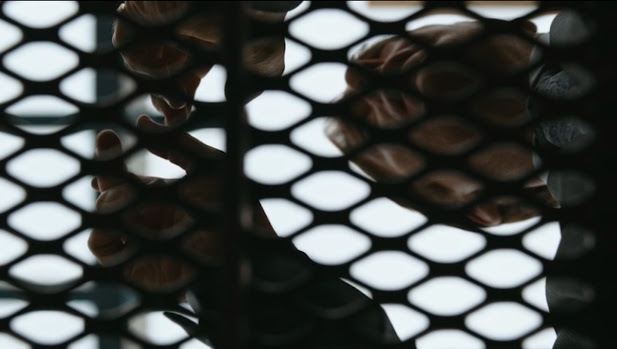This
week I'm featuring TV episodes that have been nominated for 2021 WGA
awards, and in particular the things they do in their openings.
It's a happy coincidence that this blog begins with an entry about BETTER CALL SAUL. When it comes to the "craft" of writing, you can't do better than Vince Gilligan, Peter Gould and the SAUL writing staff. Every single week seems to be a master class in storytelling.
Among their greatest strengths are their episode openings and endings. Pretty much every time out, you can count on SAUL to begin with a sequence that weds striking, revelatory visuals to character turns and plot choices you almost never see coming.
Alison Tatlock's WGA-nominated episode #507, “JMM”, is a case in point.
Then we shift to a back and forth of shots of each of them individually as seen through the mesh of the outdoor table at which they're sitting. In dialogue, Jimmy agrees to tell her the truth about what he’s doing no matter what, and she promises to accept it. It’s their "real" marriage vows, in a sense. And yet shot through the bars of the table makes it look like they're each in jail (and separate). A brilliant commentary on what they're doing.
The sequence rolls on through a discussion with the county clerk and one of the witnesses, each moment of which only adds to the sense of this wedding as doomed, romance-less calculation. The next beat builds wonderfully on that; waiting in court for the judge, the two sit together not in the gallery but at the defense table. It's the perfect expression both of what this wedding is, a defense strategy, and of their plight.
Truly, the sequence could have ended with the judge walking in. It's the horrible shotgun wedding we feared, brilliantly delivered.
But instead, Tatlock has the characters say their vows. There's no frills to them, no added comments or words; they're just the standard pro forma formula. And yet face to face with each other and the reality of what they're doing, neither Jimmy nor Kim proves able to leave the moment at the level of legal protections. For each of them the vows becomes a quiet, unexpected, funny expression of their actual love.
And just like that everything we’ve come to believe about this wedding is turned upside down.
507 has some other incredible moments, especially the ending, which again leads with a striking visual image--half of Jimmy's face reflected on a shiny wall to create this insane Jekyll and Hyde effect--
-- that becomes the jumping off point for a stunning character turn, as Jimmy
loses his mind all over Howard.
But for me, it's this moment, when everything said "This marriage is a disaster" and then their vows go exactly the other way, that I feel like I watched a great magic trick.
First, How can I make this moment, this conflict, this character More Visual. Look for images, choreography, and other visual cues that can help reveal the internal state of your characters and their choices. It adds so much depth.
Second, Consider what your audience is expecting. Tatlock knows that we left 506 thinking this wedding is a terrible idea. Playing into that at the top of 507 allows her to hide where the scene is headed.
So much of good storytelling is about manipulation and misdirection. And that's what Tatlock does so brilliantly here.
TOMORROW: BOJACK HORSEMAN



